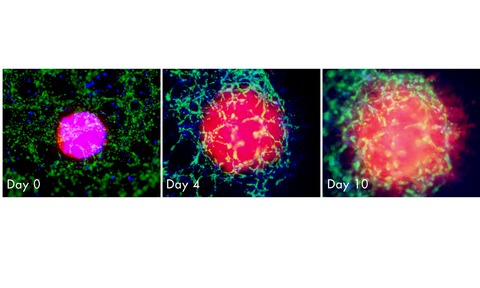
An application note from AMSBIO is claimed to introduce a more predictive and realistic model for early stage drug screening of cancer therapeutics.
Previously presented at the 2014 Beatson International Cancer conference and the ELRIG Drug Discovery 2014 meeting in Manchester, UK, the report shows that incorporating vascular and stromal cells with breast cancer tumour spheroids allows them to more closely mimic the extracellular environment, cellular architecture and behaviour of actual tumours.
The triculture promotes growth, invasion and endothelial recruitment.
3D tumour spheroids mark a significant advance over 2D models in mimicking tumour physiology.
Like tumours, spheroid cultures exhibit cell-cell bond formation, comparable morphology, elevated cell survival and proliferation in their outer layers. Within the inner layers, they have reduced proliferation rates and a hypoxic core.
While such Multi-Cellular Tumor Spheroids (MCTS) do provide a more physiological tumour model than 2D, other cell types are also essential for tumour behavior and cancer progression.
Tissue vasculature provides a critical component, given the metabolic requirements of a growing tumour and known tumour-vascular interactions.
So incorporating endothelial tubules with the MCTS adds interactions between vascular networks and growing tumours to the model. At the same time, stromal cells promote cell proliferation, dissemination, and drug resistance during cancer development.
In the Amsbio application report, a novel 3D spheroid triculture model for evaluating breast cancer progression is described.
Three different cell types are cultured together - a breast cancer cell line, human umbilical vein endothelial cells [HUVECs] and human adipose-derived mesenchymal stem cells [hMSCs] as an in vitro model for breast cancers in drug screening studies.
The proper physiology for each of these cell types is promoted using extracellular matrix proteins and their activities and interactions assessed.
The report demonstrates that in this particular triculture system, breast cancer MCTS exhibit cell-cell interactions with endothelial tubules and stromal cells, and there is an increase in both cell proliferation and invasion over the standard spheroid monoculture model.




